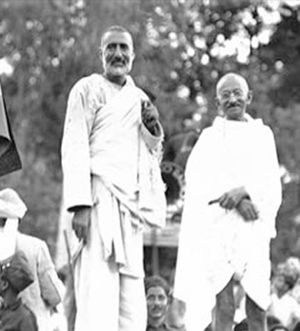भारत के विभाजन का विरोध
नेविगेशन पर जाएँ
खोज पर जाएँ



औपनिवेशिक भारत का मानचित्र (1911)

खुदाई खिदमतगार नेता खान अब्दुल गफ्फार खान और महात्मा गांधी, दोनों भारतीय राष्ट्रीय कांग्रेस से संबंधित थे। दोनों ने इस तथ्य का हवाला देते हुए कि मुस्लिम और हिंदू दोनों सदियों से शांति से एक साथ रहते आये हैं, भारत के विभाजन का कड़ा विरोध किया।[१] [२]
२०वीं शताब्दी में भारत के विभाजन का व्यापक विरोध हुआ था और अब भी यह दक्षिण एशियाई राजनीति में चर्चा का विषय बना हुआ है। जो लोग इसका विरोध करते थे वे अक्सर मिश्रित राष्ट्रवाद के सिद्धान्त को मानते थे। [३] हिंदू, ईसाई, एंग्लो-इंडियन, पारसी और सिख समुदाय बड़े पैमाने पर भारत के विभाजन (और इसके अंतर्निहित दो-राष्ट्र सिद्धांत ) के [४] [५] [६] [७] के विरोधी थे। इनके साथ ही बहुत से मुसलमान भी भारत विभाजन के विरोधी थे और ये लोग अखिल भारतीय आजाद मुस्लिम सम्मेलन से समर्थक थे।)। [८] [९] [१०]
सन्दर्भ
- ↑ स्क्रिप्ट त्रुटि: "citation/CS1" ऐसा कोई मॉड्यूल नहीं है।
- ↑ स्क्रिप्ट त्रुटि: "citation/CS1" ऐसा कोई मॉड्यूल नहीं है।
- ↑ स्क्रिप्ट त्रुटि: "citation/CS1" ऐसा कोई मॉड्यूल नहीं है।
- ↑ स्क्रिप्ट त्रुटि: "citation/CS1" ऐसा कोई मॉड्यूल नहीं है।
- ↑ स्क्रिप्ट त्रुटि: "citation/CS1" ऐसा कोई मॉड्यूल नहीं है।
- ↑ स्क्रिप्ट त्रुटि: "citation/CS1" ऐसा कोई मॉड्यूल नहीं है।
- ↑ स्क्रिप्ट त्रुटि: "citation/CS1" ऐसा कोई मॉड्यूल नहीं है।
- ↑ स्क्रिप्ट त्रुटि: "citation/CS1" ऐसा कोई मॉड्यूल नहीं है।
- ↑ स्क्रिप्ट त्रुटि: "citation/CS1" ऐसा कोई मॉड्यूल नहीं है।
- ↑ "Asia and the Americas". Asia and the Americas (in अंग्रेज़ी). Asia Press. 46: 212. 1946.
Many Muslim organizations are opposed to it. Every non-Muslim, whether he is a Hindu or Sikh or Christian or Parsi, is opposed to it. Essentially the sentiment in favor of partition has grown in the areas where Muslims are in a small minority, areas which, in any event, would remain undetached from the rest of India. Muslims in provinces where they are in a majority have been less influenced by it ; naturally, for they can stand on their own feet and have no reason to fear other groups. It is least evident in the Northwest Frontier Province (95 per cent Muslim) where the Pathans are brave and self-reliant and have no fear complex. Thus, oddly enough, the Muslim League's proposal to partition India finds far less response in the Muslim areas sought to be partitioned than in the Muslim minority areas which are unaffected by it.